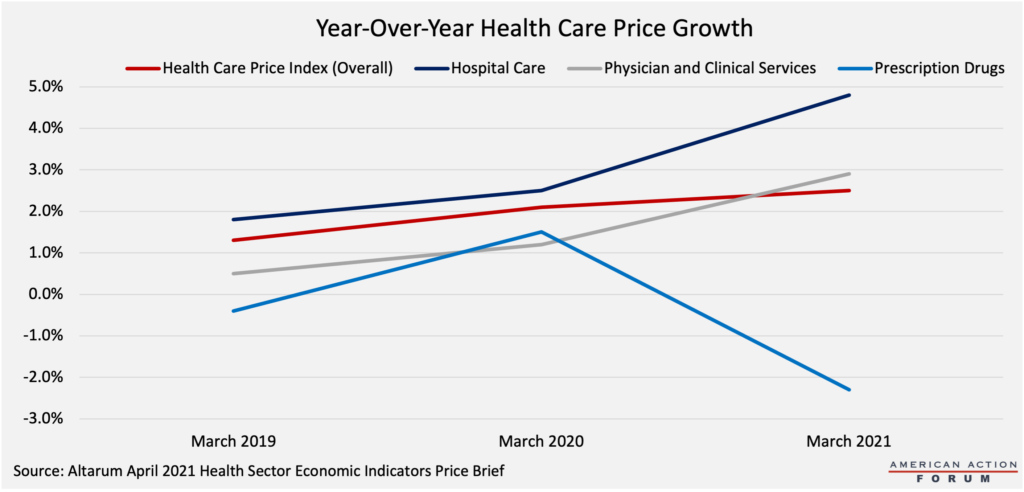Weekly Checkup
May 7, 2021
Biden Sides with Progressives in Fight Against Intellectual Property
This week the Biden Administration caved to pressure from progressives and tentatively embraced an effort led by India and South Africa to permit widespread international violations of intellectual property (IP) rights related to COVID-19 vaccines, treatments, and diagnostics. The effort, however, will not advance the global fight against COVID-19, as the Biden Administration is surely aware. IP protections are not limiting vaccine availability, but waiving them could have long-term implications for innovation.
Over 100 developing nations along with progressive activists and many Democratic lawmakers in the United States have been pushing for a waiver of the Agreement on Trade-Related Aspects of Intellectual Property Rights (TRIPS)—one of the key founding agreements of the World Trade Organization—arguing that IP protections are preventing developing countries from accessing COVID-19 vaccines. In theory, waiving IP protections for vaccines and other assorted products will allow countries such as India and South Africa to begin manufacturing vaccines themselves, thus speeding up the effort to reach global herd immunity. Given the ongoing public health tragedy in India in particular, any action that would speed access to vaccines and treatment would appear worthwhile. The proposed TRIPS waiver, however, won’t help.
The issue is that there is little underutilized manufacturing capacity that can easily be activated if only those manufacturers had the access to patent information about the various vaccines. Adar Poonawalla, CEO of the Serum Institute of India—currently the largest producer of COVID-19 vaccine doses in the world—has argued that access to IP is not limiting vaccine production; rather it is the time involved in scaling up manufacturing capacity. Similarly, Sai Prasad—president of the Developing Countries Vaccine Manufactures Network and an executive at Bharat Biotech, and Indian company specializing in vaccine manufacturing—told Reuters that waiving IP will not increase vaccine access because it is the capacity to manufacture the vaccines that is the obstacle, not access to IP.
In reality, vaccine developers have already been contracting with their competitors to make use of any excess manufacturing capacity available. In fact, Johnson & Johnson, AstraZeneca, and Novavax have all licensed their IP to Indian-based manufacturers. And for all the concern about IP preventing access to vaccines, India has yet to approve vaccines developed by Pfizer, Johnson & Johnson, or Moderna for emergency use within the country. What’s more, the Biden Administration knows that IP is not a barrier to vaccine access. Just this last Sunday White House Chief of Staff Ron Klain said in an interview with CBS News that “really, manufacturing is the biggest problem. We have a factory here in the U.S. that has the full intellectual property rights to make the vaccine. They aren’t making doses because the factory has problems.”
President Biden has clearly calculated that standing up to progressive demands to undercut IP rights isn’t worth the political price, even though he knows that waiving IP will not address the vaccine shortfall. Unfortunately, waiving IP will have downstream impacts. Once the IP has been waived, there is no way to put the knowledge back in the bottle after the pandemic, and the investments in innovation these patent holders made will be much harder to recoup. The Indian government also knows that waiving IP won’t fix the problem; instead this push is simply another front in a global fight against the basic idea of IP. But if we allow erosion of IP rights on this issue, it’s an open question if companies will continue to make the investments needed to address future public health threats.
Chart Review: Contributors to Health Care Price Growth
Tara O’Neill Hayes, Director of Human Welfare Policy
Over the past three years, overall health care prices have gradually increased, rising 1.3 percent between March 2018 and March 2019 and 2.5 percent from March 2020 to March of this year. There are, however, noticeably different rates of growth across the various health care product and service lines. For example, hospital prices grew 1.8 percent and 2.5 percent year-over-year by March 2019 and March 2020, respectively, before jumping 4.8 percent by March 2021. Prices for physician and clinical services followed the same trend, but at a slower rate, rising 0.5 percent, 1.2 percent, and 2.9 percent in each of the past three years. Prescription drug prices, on the other hand, have declined in two of the past three years: down 0.4 percent from March 2018 to 2019, rising just 1.5 percent by March 2020, and declining 2.3 percent by March 2021. These figures indicate that health care price growth is not being driven by prescription drug prices, but rather by ever-rising hospital prices primarily, particularly given that hospital care accounts for nearly 40 percent of all health care expenditures while prescription drugs account for less than 20 percent.
Tracking COVID-19 Cases and Vaccinations
Christopher Holt, Director of Health Care Policy
To track the progress in vaccinations, the Weekly Checkup will compile the most relevant statistics for the week, with the seven-day period ending on the Wednesday of each week.
| Week Ending: | New COVID-19 Cases: 7-day average |
Newly Fully Vaccinated: 7-Day Average |
Daily Deaths: 7-Day Average |
| May 5, 2021 | 45,816 | 714,665 | 656 |
| April 28, 2021 | 52,771 | 1,354,949 | 631 |
| April 21, 2021 | 62,719 | 1,429,137 | 686 |
| April 14, 2021 | 69,638 | 1,680,348 | 715 |
| April 7, 2021 | 64,394 | 1,524,050 | 638 |
| March 31, 2021 | 63,488 | 1,331,425 | 826 |
| March 24, 2021 | 57,219 | 939,282 | 858 |
| March 17, 2021 | 53,063 | 1,002,083 | 946 |
| March 10, 2021 | 54,981 | 936,362 | 1,355 |
| March 3, 2021 | 62,409 | 895,360 | 1,648 |
| February 24, 2021 | 66,328 | 829,073 | 1,984 |
| February 17, 2021 | 76,420 | 731,993 | 2,081 |
| February 10, 2021 | 103,088 | 688,064 | 2,652 |
| February 3, 2021 | 133,807 | 474,024 | 2,881 |
| January 27, 2021 | 161,218 | 329,878 | 3,230 |
Sources: Centers for Disease Control and Prevention Trends in COVID-19 Cases and Deaths in the US, and Trends in COVID-19 Vaccinations in the US
Note: The U.S. population is 330,252,151.
From Team Health
Testimony: Lower Drug Costs Now – Expanding Access to Affordable Health Care – AAF President Douglas Holtz-Eakin
The phrase “rising drug costs” is riddled with ambiguity, and some recent proposals for government “negotiation” are instead pushing for government price setting.
Worth a Look
Axios: Lawmakers seek COVID-19 money for opioid treatment
Kaiser Health News: In Appalachia and the Mississippi Delta, Millions Face Long Drives to Stroke Care











